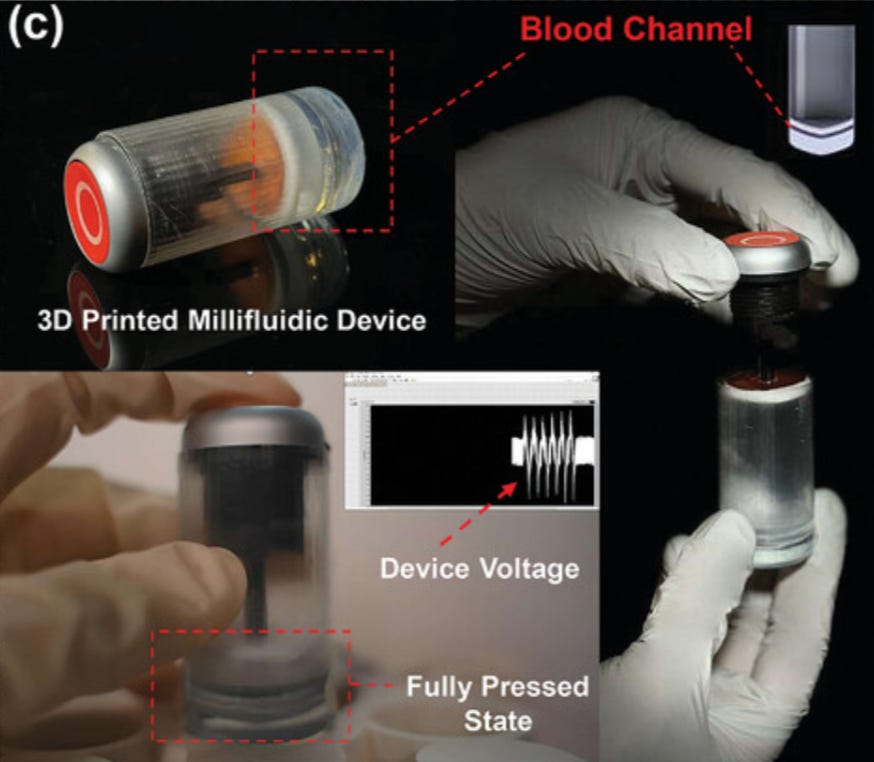Novel blood-powered chip offers real-time diabetic health monitoring
This innovative technology uses blood to generate electricity and measure its conductivity, potentially revolutionizing medical care access

Metabolic disorders such as diabetes and osteoporosis are becoming increasingly common worldwide, especially in developing countries. These conditions often go undiagnosed in remote areas where healthcare infrastructure is insufficient to support conventional diagnostic methods, like blood tests. Traditional methods are not only invasive but also time-consuming, making real-time monitoring a challenge, particularly in rural populations.
To address these challenges, researchers from the University of Pittsburgh and University of Pittsburgh Medical Center (UPMC) have developed a groundbreaking device. This innovative technology uses blood to generate electricity and measure its conductivity, potentially revolutionizing medical care accessibility.
“As the fields of nanotechnology and microfluidics continue to advance, there is a growing opportunity to develop lab-on-a-chip devices capable of overcoming the constraints of modern medical care,” said Amir Alavi, an assistant professor of civil and environmental engineering at Pitt’s Swanson School of Engineering. “These technologies could transform healthcare by offering quick and convenient diagnostics, ultimately improving patient outcomes and the effectiveness of medical services.”
Understanding Blood Conductivity
Blood electrical conductivity is a crucial indicator for assessing various health conditions. It is mainly influenced by the concentration of key electrolytes, such as sodium and chloride ions, which are vital for numerous physiological functions.
“Blood is essentially a water-based medium containing various molecules that conduct or impede electric currents,” explained Dr. Alan Wells, the medical director of UPMC Clinical Laboratories. “Glucose, for instance, is an electrical conductor. We can observe its impact on conductivity through these measurements, allowing us to make a diagnosis on the spot.”
However, understanding blood conductivity is challenging due to measurement difficulties like electrode polarization, limited access to human blood samples, and the complexities of maintaining blood temperature.
Measuring conductivity at frequencies below 100 Hz is crucial for gaining deeper insights into blood's electrical properties and biological processes, but it remains particularly difficult.
Related Stories:
The Portable Lab-on-a-Chip Device
The research team has proposed a novel, portable millifluidic nanogenerator lab-on-a-chip device that can measure blood at low frequencies. This device utilizes blood as a conductive medium within its integrated triboelectric nanogenerator (TENG).
The TENG system works by converting mechanical energy into electricity through a process called triboelectrification.
Triboelectrification involves the exchange of electrons between contacting materials, resulting in a charge transfer. In a TENG system, the transfer and separation of electrons generate a voltage difference that drives an electric current when the materials move relative to each other, such as during compression or sliding. The team measures the voltage produced by the device under specific conditions to determine the electrical conductivity of the blood.
One of the standout features of this device is its self-powering mechanism, which enables its miniaturization. The researchers also employed artificial intelligence models to estimate blood electrical conductivity directly from the voltage patterns generated by the device.
To validate the device's accuracy, the team compared its results with those from traditional blood tests, finding that it performed successfully. This breakthrough paves the way for bringing diagnostic testing to people where they live, bypassing the need for advanced laboratory facilities.
Moreover, the blood-powered nanogenerators can function within the body wherever blood is present. This capability enables self-powered diagnostics by analyzing local blood chemistry, offering a promising solution for continuous health monitoring.
Implications for Global Health
The potential impact of this device on global health is significant. In areas with limited access to healthcare, such a portable and easy-to-use diagnostic tool could mean the difference between life and death. By providing real-time, on-the-spot diagnostics, this technology could facilitate early detection and treatment of metabolic disorders and other health conditions.
“This innovation represents a significant leap forward in medical diagnostics,” said Dr. Wells. “With the ability to diagnose conditions quickly and accurately, we can improve patient outcomes and enhance the delivery of medical services, especially in underserved regions.”
As metabolic disorders continue to rise globally, the development and implementation of advanced diagnostic tools like this lab-on-a-chip device are crucial. They not only offer a solution to the challenges faced by current diagnostic methods but also hold the promise of transforming healthcare delivery worldwide.
The Future of Diagnostics
Looking ahead, the integration of nanotechnology and microfluidics in healthcare could lead to even more sophisticated and accessible diagnostic tools. As researchers continue to refine these technologies, we can expect to see a shift towards more personalized and decentralized healthcare models.
For now, the portable millifluidic nanogenerator lab-on-a-chip device marks a significant milestone in this journey. It exemplifies how innovative engineering and cutting-edge technology can address pressing global health challenges, bringing hope to millions of people in remote and underserved communities.
The continued advancement in this field could lead to a future where healthcare is not constrained by geographical or infrastructural limitations. Instead, it could become more inclusive, equitable, and capable of providing timely care to all.
The development of this new diagnostic device is a testament to the power of interdisciplinary research and its potential to make a tangible difference in people's lives. As we embrace these technological advancements, we move closer to a world where quality healthcare is accessible to everyone, regardless of where they live.
Other researchers on this project include:
Jianzhe Luo, PhD Candidate, University of Pittsburgh
Wenyun Lu, PhD Candidate, University of Pittsburgh
Daeik Jang, Postdoctoral Associate, University of Pittsburgh
Qianyun Zhang, Civil engineering professor, New Mexico State University
Wenxuan Meng, PhD Candidate, University of Pittsburgh
The paper, “Millifluidic Nanogenerator Lab-on-a-Chip Device for Blood Electrical Conductivity Monitoring at Low Frequency,” was recently published by the journal Advanced Materials.
For more science news stories check out our New Innovations section at The Brighter Side of News.
Note: Materials provided above by The Brighter Side of News. Content may be edited for style and length.
Like these kind of feel good stories? Get the Brighter Side of News' newsletter.
Joshua Shavit
Science & Technology Writer | AI and Robotics Reporter
Joshua Shavit is a Los Angeles-based science and technology writer with a passion for exploring the breakthroughs shaping the future. As a contributor to The Brighter Side of News, he focuses on positive and transformative advancements in AI, technology, physics, engineering, robotics and space science. Joshua is currently working towards a Bachelor of Science in Business Administration at the University of California, Berkeley. He combines his academic background with a talent for storytelling, making complex scientific discoveries engaging and accessible. His work highlights the innovators behind the ideas, bringing readers closer to the people driving progress.



